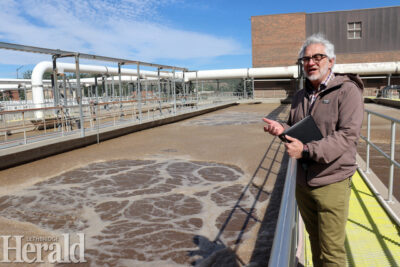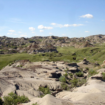City working hard to meet demand at wastewater treatment plant
By Lethbridge Herald on June 4, 2024.
 Herald photo by Al Beeber
Doug Kaupp, general manager of the City's Water and Wastewater department, discusses the role of the bio-reactors which play a critical component in the treatment of sewage at the wastewater treatment plant.
Herald photo by Al Beeber
Doug Kaupp, general manager of the City's Water and Wastewater department, discusses the role of the bio-reactors which play a critical component in the treatment of sewage at the wastewater treatment plant.Al Beeber – LETHBRIDGE HERALD – abeeber@lethbridgeherald.com
Doug Kaupp knows first-hand the challenges faced by the City as it looks to meet the increasing demand for water which is needed by housing, industrial and institutional users alike.
Most projects involving water and wastewater in the last quarter century have involved replacing aging equipment as they reach the end of their life cycles.
And the City, Water and Wastewater general manager Doug Kaupp told The Herald last summer, is facing challenges to keep up with the load on the city’s treatment facility in the river valley adjacent to Peenaquim Park.
A large amount of load on the waste water system comes from industry with a substantial increase being seen in the past five to six years.
On Tuesday, Kaupp led a media tour of the wastewater plant, discussing with reporters every facet of the treatment system from the start as raw sewage reaches the plant to the end as treated water returns to the Oldman River.
Last fall, a standing policy committee of city council was told by Kaupp that the wastewater treatment plant is presently operating at 99 per cent of capacity while on peak days, the water plant operates at 90 per cent.
At peak demand, residents can use up to 130 million litres of water in a day.
Thirty million litres of treated wastewater is returned daily to the river after an extensive treatment process that separates liquids from solids and sludge, removes phosphorus and nitrogen and lets the City meet provincial standards.
Most projects done in the past 25 years have been aimed at replacing equipment but in the past couple of years, the City has experienced challenges to keep up with the treatment load.
Kaupp was co-designer of a patented system used by Lethbridge in the treatment of its water which uses three bio-reactors between six and seven metres deep, a system that basically speeds up a process used in nature itself.
Three 1,500 horsepower blowers provide oxygen to the bio-reactors, only one of which operates at any given time. At the most, two would be used with the third being primarily a backup.
Raw sewage from 45,000 households which reaches the plant every day has what Kaupp accurately, even on a windy day, calls a sweet sickening smell and a tinge of green.
Sixteen staff work daytime hours at the plant which operates seven days a week. The plant is monitored constantly by a computer system.
Upon the sewage’s arrival at the plant, grit and other solids, which can even include golf balls and other household items, are screened from it and taken to the landfill. Grit and sand are separated by a cyclonic system.
The plant has two primary clarifiers where 30 per cent of pollutants are removed with sludge getting pumped away for solids treatment. Eventually two more clarifiers will be coming onstream.
Kaupp says 50 to 60 years ago the primary clarifier portion of the process would have been the entire treatment process.
At the bio-reactors, bacteria “chomp away” at the sewage and gets rid of the organic material in the primary effluent.
Regulations now require nitrogen and phosphorus to be removed which is where the system that chemical engineer Kaupp helped develop comes into play.
The system includes an anaerobic zone to condition phosphorus-removing bacteria that consume the phosphorus in their own cells to stay alive. Further down, oxygen is added and the stressed bacteria then consume multiple times more phosphorus.
The third stage of the bio-reactors is an anoxic zone for removing nitrogen.
The work done in the bio-reactors is repeated four times and Kaupp says it is “a very effective process.”
Wastewater is also given an ultraviolet light disinfectant treatment with two banks of lights housed in one building on site.
All buildings on site are accessible through a series of underground tunnels where not only electrical wiring runs but also all the pipes required for the plant which makes repairs easier, especially in subzero temperatures.
The ultraviolet light inactivates micro-organisms through a process that renders them incapable of reproduction and infection, the process which alters the DNA and RNA of the microbes.
Sludge from the primary clarifiers is transported to secondary clarifiers where it ends up in anaerobic digesters. These digesters further break down and stabilize solids which are transported to the lagoons visitors to Peenaquim Park will see behind high wire mesh fences at the north end past Softball Valley.
That sludge is hauled to farmers fields for use as fertilizer by a contractor through a City program. That fertilizer can only be used on certain types of crops because of the potential of pathogens, said Kaupp during the tour.
One piece of equipment, which Kaupp calls the best maintained equipment in Canada, is a gravity belt thickener which is a critical part of the treatment process. With no redundant system in place at the plant, it’s crucial for the City to keep it operational. A Capital Improvement Plan project item calls for the replacement of this component with different technology to take the pressure off of it.
Kaupp told The Herald last year there is a need to amend the 2022-31 CIP to advance projects needed to significantly increase the capacity of the utility to address future anticipated demands upon it.
As of last fall, the total capital cost of Phase 1 water utility projects was $123 million. This figure included $85 million for the water treatment plant and $38 million for transmission and storage. Borrowing required for the project was up to $92,442,000.
Total capital cost of Phase 1 of the wastewater utility projects was $88 million.
Council, in its capacity of Economic Standing Policy Committee last fall tasked administration to provide a report in the second quarter of this year with options on making improvements. It turned down a request by Kaupp to approve an expenditure that would have seen water and waste water rates increase by amounts that could have seen the average residential water bill rise from $60 a month to $75.
33-32





Gotta wonder… are we going to have to wait until the financial drain on city coffers of the new Lethbridge Exhibition Corporate-Welfare-Taj Mahal fiasco is finally cleared and balanced, or even profitable, before a city council will fund these upgrades? Sheesh… we’ll all be knee high in back upped sewage in our basements if that is the case !
Nailed it. Was past the Taj on the weekend. 2 – 4H clubs holding their sheep get together on Saturday morning with livestock. New building empty, event in the north pavilion, WHERE THERE ARE FLOOR DRAINS. Good thing they were knocked down for more parking.